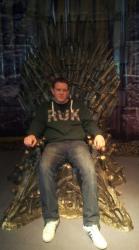“Whether your transformation happens through trauma, surprise, or intention, the process begins because of a growing need for change.”
The build-up and subsequent release of Batman in 1989 ushered in a new kind of blockbuster and a new way of marketing them. Some of its effects were immediate, others slow building. Its impact on the movie and the marketing industry is something that can still be seen today.
Movies like Jaws and Star Wars had ushered in the new phenomenon known as the blockbuster (given their moniker after the swarms of people stretched around the block to enter the cinema was likened to the aerial bombs capable of destroying a whole block of streets of the same name) Batman would take it to another level.

This wasn’t just a movie, it was a corporate juggernaut of fevered anticipation, hype and preordained success.
Its announcement followed an unprecedented wave of cross-promotional marketing saturation unlike anything the industry had ever seen. The summer of Batman would see everything from toys, clothing, fast food tie-ins, breakfast cereal, arcade games and skateboards arriving in stores.
This all served to coronate Batman as the biggest movie event of the year long before its June release. Even Time Square was gripped with “Bat-Mania” with the movie’s now iconic poster taking up the world’s most valuable piece of real estate. The poster itself (above) was simplistic genius. There was no mention of the marquee names of its stars or its director or even the name of the movie for that matter. The cropped logo seen to be almost too big to be contained within the confides of a mere poster and was accompanied by one simple piece of text “June 23”
The marketing was an unequivocal success with Batman merchandise raking in close to €800 million dollars before the movie was even released!

A lot of this success, however, would not have been possible had Warner Brothers, specifically producers Jon Peters and Peter Gruber, not released a then unheard of concept… the teaser trailer:
With the reaction to the casting of a comedy actor of average physique in Michael Keaton as the perfect psychical specimen of Batman being almost universally negative, the studio’s offices were flooded with over 50,000 protest letters demanding a re-cast. The outcry was so big; it even caused a drop in Warner’s share price. Gruber and Peters needed to find some way to coax movie goers back to the ship before it hit the rocks.
The first port of call was to secure a big name to add gravitas to the project.
The 80s was still very much in the grip of star power being used to open movies: with names like Tom Cruise or Eddie Murphy above the credits you were guaranteed an audience. Superman in 1978 had done the same thing by adding Marlon Brando as Jor-El. Adding an A list calibre actor was used to have the film stand out from previous box office duds like Howard The Duck and Supergirl. Brando was paid $3.7 million for two weeks of work in what amounted to little more than a cameo. With Batman being seen as the biggest movie ever at the time, Warner Brothers set their sights on arguably the biggest movie star ever… Jack Nicholson.

At the point the studio came knocking, Nicholson had nine Oscar nominations and two wins under his belt, he had starred in bona fide classics like Chinatown, One Flew Over the Cuckoo’s Nest and The Shining to name but a few. Casting an icon of the silver screen would mitigate the risk of casting a comedy actor in the main role as well as the relatively inexperienced director.
Nicholson would, however, not come cheap and was finally signed for a then record payday of $10 million. However, the real stroke of genius was his contract including a percentage linked to the box office take and merchandise for the Batman movie, along with percentage points on the sequels too. Thus, even though Nicholson didn’t appear in Batman Returns, Batman Forever or Batman & Robin, he profited from them. In all, for his work as The Joker, Nicholson was said to have pocketed over $100m in total… and counting.
With shooting commenced and the studio looking to alleviate the fans’ concerns they cobbled together a 90 second teaser trailer to be shown 6 months before the film’s release (see above). Noticeably missing was Danny Elfman’s iconic music (which was not yet recorded) and the trailer bears little resemblance to modern trailers, looking almost like a bootleg version. Its effects however were seismic. In a pre-internet age, word spread like wildfire and fans were buying tickets to movies they didn’t even want to see, just to get a look at the teaser; once it finished, they’d leave the screening before the film had started.
With “Bat-Mania” in full effect, the movie would have to perform spectacularly to live up to the unprecedented hype.
1989 was already a record-breaking summer at the box office; Indiana Jones and the Last Crusade and Ghostbusters II had already broken the previous opening weekend records with $29.3 million and $29.4 million respectively. Batman would blow them out of the water with a three day haul of $40.4 million. It didn’t let up either; in 10 days it had broken €100 million in less than twenty it had reached close to €200 million.

The legacy of the summer of Batman was that studios – that previously had to wait for home movie release to see big returns on their investment – could see huge short-term profitability was an achievable goal.
Now it’s the only goal, with movies living and dying on their opening weekend grosses. Batman was more than a movie, it was an event. This wasn’t something you had the option to go to, it was an obligation. Not seeing the movie meant you were unable to participate in everything from conversations about the movie to the arcade and board games.
This, perhaps more than anything, is what the modern studios are trying to replicate. You can see this in the current summer blockbuster landscape. Studios seek out pre-established brands (preferably comic book), release dates are set in stone years in advance, often to the detriment of the script. Viral marketing, trailers, teaser trailers… and now there are even teasers for teaser trailers. Merchandising deals on everything from airlines to condoms. All designed to make sure that you are sitting in that cinema seat on opening weekend to contribute to the now almighty weekend gross.
The movie also changed the landscape of the action hero.
No longer did you need arms like tree trunks to carry a movie. Actors like Nicolas Cage, Matt Damon and Tom Cruise would all be seen as viable action heroes in the years following Keaton’s turn as the Dark Knight.

Batman would simultaneously create and destroy the summer movie. The magic of finally seeing iconic characters like Batman and The Joker on the screen would be lost with the saturation of seeing every character imaginable given its own cinematic incarnation in the hope of replicating its success. It made the opening weekend all important, it created the PG-13 rating which every film now seeks in order to cash in on both child and adult markets.
The positives to come out of the movie was that it proved there is a market for adult targeted comic book movies with more serious themes and made it acceptable for big name and talented actors to step into the world of Spider-Man and The Hulk. The summer of 1989 was, for many, the Camelot of the summer blockbuster. It heralded the arrival of the cynical corporate age of movie making while still retaining the wonder and magic that films like Jaws and Star Wars had done in years previously.
There’ll never be another Camelot again…






Nerd Comments